Meet the member behind the winning entry to our nature photography competition They did




Meet the member behind the winning entry to our nature photography competition They did



Keeping you informed and helping you to live well with PH
Our wide range of titles cover topics from medication to menopause, palliative care to pregnancy – and much more.
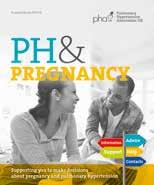


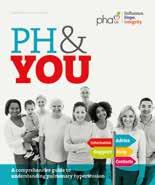
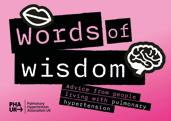





Click to see the full library and order your copies, or visit phauk.org/publications


We're all still smiling here at the PHA UK following what was a hugely valuable event in Birmingham in August. It was such a pleasure to bring so many of you together to mark our 25th anniversary and we hope you took as much from the day as we did. Getting together in person is really special, isn’t it? We hope to do more of it in 2026, so keep your eyes peeled for news.
As always, it’s a packed edition of emPHAsis. On page 9 we bring you the findings of a very important study to understand which symptoms of PH impact people most. Over 250 of you completed our survey earlier in the year, and the results will now underpin much of our work over the coming months. You can see the full report, which includes new video interviews with PHA UK members, at phauk.org/BeyondBreathlessness
This issue also celebrates some of the selfless fundraising that’s taken place over the last few months. It really is incredible to see the efforts from our community,
and I’d like to say a personal thank you to everyone who has gone the extra mile for us this year. You can read about recent activities on pages 21 and 67
I’m also very grateful to everyone who sponsored myself and Javier Jimenez, Clinical Nurse Specialist at the Royal Free Hospital, for our swim challenge in September.
Enjoy this issue and thank you for being part of the PHA UK family this year. I wish you a peaceful and enjoyable festive season and a positive start to 2026.


THANK YOU TO EVERYONE WHO HAS CONTRIBUTED TO EMPHASIS THIS YEAR
Iain Armstrong Chair of the PHA UK media@phauk.org

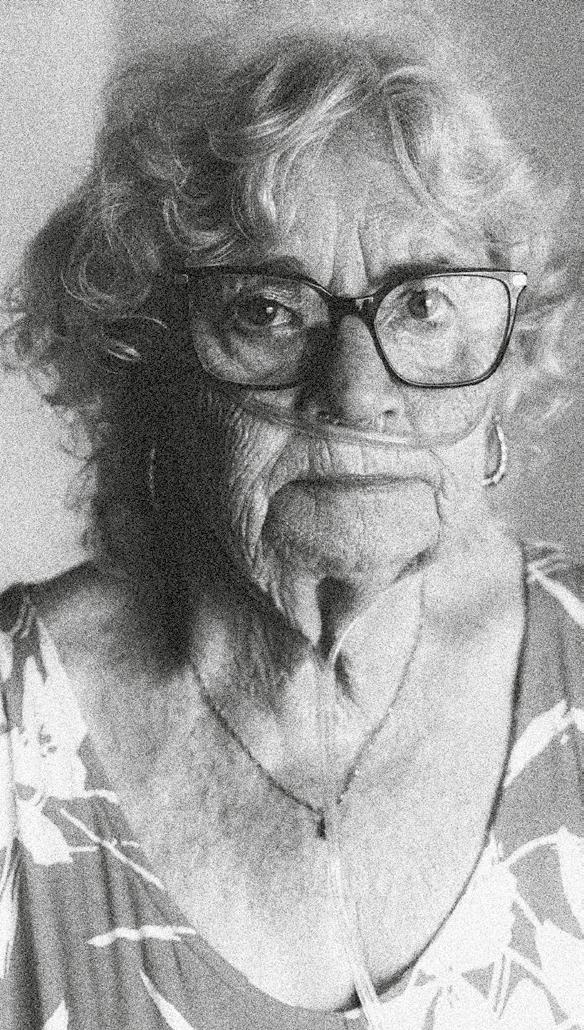






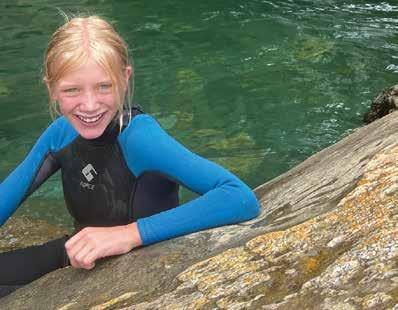

At
Nora Green isn’t letting her age or her health conditions get in the way of having
It was a pleasure to welcome more members to our office in Sheffield, when we held our second Tea & Talk event in September.
This was the latest in our series of informal gatherings, designed to bring PHA UK members together in a relaxed and welcoming space. Attendees enjoyed hot drinks and nibbles, and shared experiences and advice together. Whilst online groups and forums are fantastic, there's something really special about meeting face-to-face.
We'll be holding another Tea & Talk event early next year so keep an eye out for details. Travel grants of up to £50 per person will be available, to ensure the event is as inclusive as possible and to enable people who live a long distance from Sheffield to attend.
Feedback from our September gathering:
“A very well-structured meeting, covering many areas. I found experiences of others very interesting and the advice very valuable. I think the team did really well and I met lovely people.”
Jo
“I had a fantastic time and met some lovely people. We had lots of laughter and listened to some inspiring stories. A great afternoon, thanks for having us, you all do such a fantastic job and it is wonderful to be a part of it."
Paula
“Thank you to everyone. It was nice to meet the team and everyone else and to hear the advice and everyone else's experience of PH. So thank you once again and keep up the excellent work.”
Joe
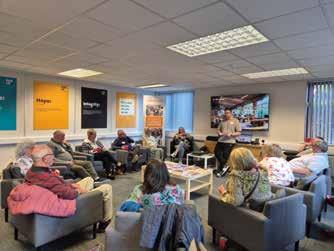


I have just been diagnosed with chronic thromboembolic pulmonary hypertension following a stay under the care of the team at Hammersmith Hospital. On completion of my stay I was given a copy of your PH & You booklet. I did not know anything about PH until I was advised to visit Hammersmith by a heart specialist at Worthing Hospital.
I have found your booklet a good read and a comfort. It is full of other people explaining their experiences, that I can now relate to looking back. I have also been given your Medication & PH booklet which is most helpful too. Too much information for a non-medical person like me can be overwhelming at times but I have been very fortunate to have fantastic care and top professional treatment from the PH team at Hammersmith.
Here are some photos from our holiday in Somerset. The highlight of the holiday was not in Somerset but when we drove to Wiltshire to Longleat Safari Park. The photos show a monkey checking his face in the wing mirror, taken by me, and a giraffe up close and personal taken by my husband Kevin. The third photo of me on the pedal boat was taken by my son Avromi.
The best of our Somerset trips was when we went to the American museum which had an American Space Exploration Exhibition. The staff assured me that I could get round the museum on my mobility scooter but the reality was the size of the rooms were too tight. I suppose the hardest thing about the holiday was arranging the oxygen delivery. The bungalow was owned by a company and we were fortunate that the cleaner took receipt of the oxygen. However it took many phone calls to make sure all parties understood what we needed. I always book a place with one or two extra bedrooms to house my oxygen cylinders and my concentrator.
There was sunshine every day of the two-week holiday. We had a lovely time.
Mandy Goodman
Just to share a small part of my story has helped a lot. Not talking or sharing hasn’t helped until now, but to be fair, we never knew what was happening to my health so I just thought it was part of getting a little older… how wrong can you be.
I thought I must send you feedback on your excellent guide to understanding PH.
Best wishes,
John Lock

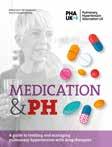


We love to hear from you! Email your letters to media@phauk.org or write to Unit 1, Newton Business Centre, Newton Chambers Road, Thorncliffe Park, Sheffield S35 2PH

News, musings and more...
We asked this question on our Facebook page and you shared some really kind words. Here are a few of your comments…
Louise PHA UK helps with great advice and offers fabulous support. Many resources are available to tap into which is a great comfort. All at PHA UK are very friendly and truly make you feel like you are part of the community. I give many thanks to this charity for helping me and my family understand PH better and helping gain more knowledge of dealing with PH on a daily basis
Karen PHA UK is a lifeline for newly diagnosed people. I know my first choice for info on PH was Google and that was a BIG mistake! Learning about PHA UK was a godsend for me. Thank you!
Carolina I love the community that PHA UK helps bring together! Events like the Together25 conference and the Tea & Talk days are such great initiatives that make me feel a lot less alone. On top of this, the resources you provide are so helpful and I'm very grateful to have the PHA UK advocating for me in ways that I can't. Thank you for all your hard work and commitment to helping us in whatever way you can!
Did you know there's now a free online tool to help you find Blue Badge parking spaces? Simply click the button or visit phauk.org/parking and enter your postcode or location to track down nearby spaces. The tool is provided by confused.com

We’ve teamed up with Great Ormond Street Children’s Hospital to publish a new printed resource to help schools understand more about pulmonary arterial hypertension (PAH).
It includes the voices of real children living with PAH, who share the challenges they can encounter at school, with expert advice to make things easier for them. As well as highlighting the facts about the disease and how it impacts young people, the booklet provides practical tips on supporting pupils, and guidance on how to spot when something may be wrong.
You can order a free copy by clicking the button or visiting phauk.org/PAH&PUPILS
The new PAH treatment sotatercept will be reconsidered following an initial decision not to commission it for use by NHS England.
The decision by the National Institute of Clinical Excellence (NICE) was announced at the end of August, based on the evidence presented to them at the time.
A consultation period has since taken place, with more evidence submitted. At the time of going to print, a second appraisal committee meeting was being arranged. We understand that the Scottish Medicines Consortium will be considering a decision early next year. We will keep you informed of developments across the UK.
PATIENT RESPONSES

CAREGIVER RESPONSES
Earlier this year, we asked people living with pulmonary hypertension – and their caregivers too – to share which symptoms affect them most.
We received 232 responses from patients and 35 responses from caregivers, and with early analysis showing the prevalence of fatigue and tiredness, these surveys were followed swiftly by a questionnaire aiming to understand how patients decipher the difference between the two symptoms.
It is well-known that breathlessness is a huge burden of PH, and this is treated as part of clinical care.
However, fatigue, which is often overlooked in terms of treatment priority, was described by patients as a severe and persistent symptom. This study provides strong, real-world evidence that clinical prioritisation needs to reflect this.
KEY FINDINGS
OVER THE PAGE >>>
“My breathlessness affects every aspect of my life.”
“Coughing has disrupted my daily life by causing discomfort, chest pain, or even difficulty speaking or breathing.”
“Fatigue really affects my social life with friends and family.”
“The palpitations always occur when I’m at rest, they’re quite disconcerting.”
“I feel like I’m
missing out on so much because I’m just too tired all the time.”
The most common symptoms that patients have experienced over the last year are breathlessness, fatigue, tiredness and sleepiness, and palpitations/heart flutters.
BREATHLESSNESS was experienced by...
27% of people at rest
73% whilst carrying out daily tasks
92% on exertion / exercise
FATIGUE & TIREDNESS was experienced by 85% of people
SLEEPINESS (as a result of poor sleep) was experienced by 56% of people
PALPITATIONS / HEART FLUTTERS were experienced by 54% of people
The symptoms that have impacted patients the most over the last year are breathlessness, fatigue, and tiredness.
BREATHLESSNESS
64% have been impacted the most by breathlessness on exertion / exercise.
49% have been impacted the most by breathlessness whilst carrying out daily tasks (such as washing and dressing).
FATIGUE & TIREDNESS
59% have been impacted the most by fatigue and tiredness.
Respondents said weather (extreme cold or heat), stress, and sleep have the biggest impact on the fluctuation of symptoms.

The most common symptoms that caregivers have noticed their loved ones have experienced over the last year are breathlessness, fatigue, tiredness and sleepiness, and cough.
The symptoms that caregivers say have impacted their loved ones the most over the last year breathlessness, fatigue, and tiredness.
“Completely life changing for both of us. Daily symptoms are debilitating for him and has involved a complete overhaul of our future plans.”
“Her condition is affecting her ability to walk to school, so much so that she has to have a taxi which incurs a cost now.”
Patients were asked to describe ‘TIREDNESS’ and ‘FATIGUE’ and what the two symptoms feel like for them. They were then asked to describe the key differences between the two, and responses included:

“Tiredness
“My husband is increasingly reluctant to leave home.”
“Fatigue is a cause of tiredness and vice versa. They are so
closely linked it’s difficult to differentiate.”
is more temporary but fatigue is more persistent and debilitating.”
“Tiredness
is an everyday daily struggle and fatigue is its master!”
“Tiredness
is more sleep based, fatigue is a whole body exhaustion.”
Overall, the findings reveal the profound impact of PH on individuals and those around them, and the results will be shared with healthcare teams, service providers, commissioners, and the pharmaceutical industry too. Here at the PHA UK, they will be used to help us provide support in the most effective ways – and they will add to the evidence base used in drug access work, highlighting why more effective treatments are needed.
You can see the full report and access all the findings by clicking the button or visiting phauk.org/BeyondBreathlessness





The report features video interviews with four PHA UK members, bringing the findings to life by highlighting the real-world impact of symptoms. We’re grateful to Jayne, Nora, Emily, and Paula for welcoming us into their homes and sharing their experiences so candidly. You can also see their videos at phauk.org/OurSymptoms


We are grateful to everyone who responded to this important survey. The symptoms of PH go beyond breathlessness – and the experiences shared will make a difference where it really matters.

Five years after being diagnosed with pulmonary hypertension, Julie Bestwick is now enjoying moving more – thanks to the support of her husband Stephen. In this special feature, the pair share their individual experiences and advice…
Stephen has always encouraged me to exercise, and his enthusiasm is extremely motivating. He helps me with everyday life, and I totally trust him to guide me through exercise. I’m not a natural exerciser like Stephen but I recognise the value that it adds to my life.
Stephen suggested that I join the gym and take a steady approach, following advice from my specialist centre and the cardiologist I see at my local hospital.
Walking through the gym door for the first time was concerning me, but I
needn’t have worried as we were given a warm welcome by Sam on reception. We were shown around the gym and facilities, and I felt at ease immediately.
The gym we chose caters for health referrals and the disabled facilities there are excellent. My GP arranged a health referral for me which gave me three months for free to try the gym before deciding to join.
I booked an induction course with a personal trainer, Karen, after encouragement from Stephen.
I discussed with her my health issues
CONTINUED OVERLEAF... Julie

and breathlessness, and Karen showed me exercises specific to what I could manage, as well as how to correctly use the equipment.
On my first visit I only managed ten minutes very slow walking on the treadmill, and I was disappointed.
However, Stephen encouraged me, reminding me it was more than I achieved during an outing the previous week. That’s what I decided to focus on. I had two options – give it up or carry on, and I knew I could do better. I hadn’t experienced extreme breathlessness or pain, and I knew I must persevere.
My first treadmill times were only ten minutes but then I built up the time and speed gradually. I now manage a slow walk for 30 minutes on the treadmill twice a week, some arm and leg exercises on the machines with either no weight or a low weight, and my favourite – a chair-based exercise class.
My gym visits have greatly improved my mobility, confidence, mental attitude and positivity.
Most people in the chair-based exercise class are attending following a health referral. The class leader guides us through some yoga breathing exercises, strength exercises (sometimes with a band or a ball), and a few minutes of cardio.
We do sit-to-stand exercises, which have greatly helped me to stand up from the sofa at home without having to push myself up, and lastly - but most importantly - the warm up and cool down exercises.
I started the class approximately five months ago and including the two other gym visits, that makes it three times exercising each week. If I’m tired or fatigued I do pass on my usual day for treadmill exercise – after all, I’m not in a race.
I have noticed that there are varying levels of fitness in the gym, but everyone has a common goal to improve their fitness. There are people with oxygen both in my class and in the gym.
I am in awe of a man who walks with oxygen for 50 minutes, four times a week, and we always have a Friday morning chat whilst walking side by side.
After each visit I feel rejuvenated after a well-earned shower followed by a coffee. I know I still need to get fitter and lose some weight, and I am trying to achieve this, but I am realistic with my targets.

I love a walk on the flat in the fresh air listening to the birds, but I know that if it’s too hot or cold, I can still go the gym and use the treadmill. I would encourage everyone to just at least try it; there’s nothing to lose. Stephen
Iam not a trained professional, but I am enthusiastic about everything fitness. My wife Julie was diagnosed with PH in April 2020. The diagnosis had a profound impact both physically and mentally. Julie’s confidence was impacted by the news as she was already living with sarcoidosis of the lungs.
After consulting her specialist centre, Julie was encouraged to carry on her exercise.
Originally, we found some flattish walks, but living in the Peak District this wasn’t always easy! There were issues with the weather too – sometimes too hot, sometimes too cold, or sometimes simply wet and miserable.
Not deterred, I suggested joining a gym. We investigated and found a local council run gym ten minutes away from us. We were greeted by Sam who quickly established our fitness requirements. Sam recommended Julie speak to her GP and request a health referral which would give her 12 weeks free gym membership before deciding to join. Although she was apprehensive, I insisted Julie had an induction session with a personal trainer. This proved very successful as Karen
explained all the gym equipment and their correct use in detail. Karen was her first friendly face.
Fast forward to today and Julie is now enjoying walking on the treadmill, using light weights and attending a chair-based exercise class. It has been a pleasure watching Julie’s newfound confidence grow, and the importance of interacting with others in the class.
Originally Julie struggled to walk for ten minutes very slowly on the treadmill. However, I pointed out that was ten minutes more than last week, and now Julie has gradually built up to 30 minutes. The gym has put a big smile back on her face.
Going to the gym has increased Julie’s confidence, mobility, posture and mental wellbeing. Additionally, it has motivated and encouraged me to get back to the gym and improve my overall fitness too. We enjoy exercising together.

I’ve learned a lot from supporting Julie to benefit from exercising at the gym. Here is my advice on getting started and making it work for you:
• Before undertaking any exercise consult your specialist PH nurse or GP.
• Where possible, find a gym within 20 minutes travelling time.
• Contact your GP to discuss a health referral and whether they have any information on participating gyms.
• Local council gyms usually offer rehabilitation classes and health referrals (with a free period offer or reduced membership).
• Wearing clothes that wick away sweat is more comfortable than wet cold cotton.
If you’d like to share your own exercise experiences or advice, please email media@phauk.org
• Sport shops will advise on correct footwear and clothing. Some outdoor shops are also very knowledgeable.
• Sign up to a class to interact with others and make friends.
• There’s no need to feel wary or uncomfortable. Only you know it’s your first visit – everyone else is busy working on their own fitness!
• When you have exercised, enjoy a well-deserved coffee break with friends in the gym’s café.
• Enjoy the benefits of exercise, interacting with others, and making new friends!
You’ll find expert advice, information, videos, and real-life experiences of exercising with PH on our website. Click the button or visit phauk.org/MoveMore to benefit from resources that cover:
• The importance of exercise
• Busting myths around exercise
• Moving for weight loss
• Turning ‘activity’ into ‘exercise’
• Walking to get fitter
• How to develop your exercise
Always speak to your specialist PH team before embarking on a new exercise routine

Smartwatches are a great way of tracking steps, distance, heart rate, blood oxygen levels, stress monitoring, calories burned and sleep patterns. Apple, Fitbit, Garmin, Samsung and more offer an array of features. Most users just want a watch that looks good and provides the specific information personal to their health requirements.
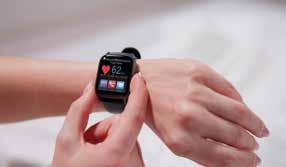

COMING SOON!
We are currently working on a brand-new publication to support people with PH to benefit from safe exercise with pulmonary hypertension. Keep an eye out for its launch in 2026!


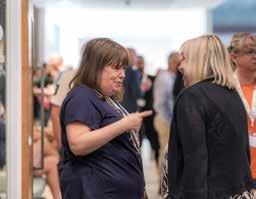

August saw a very special gathering in Birmingham, as over 100 PHA UK members came together for a day of learning, connecting, and anniversary celebrations.
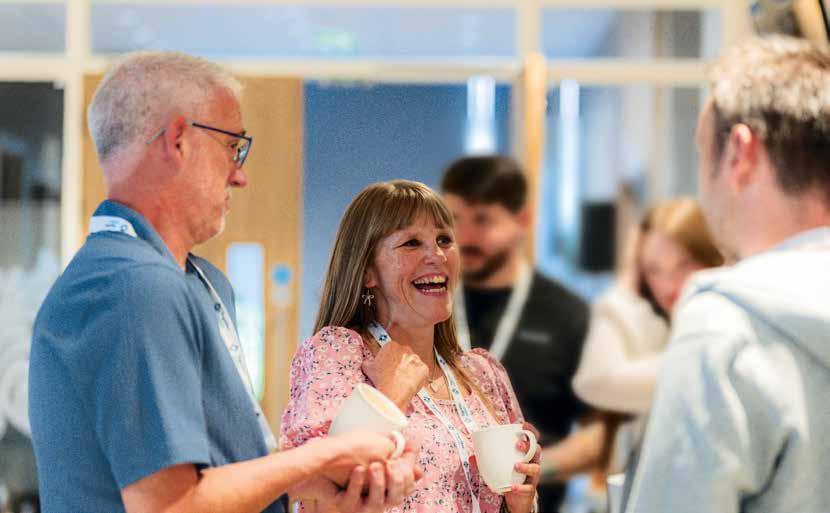
Together25 was held at the Edgbaston Park Conference Centre and Hotel to mark the 25th anniversary of our charity. Patients from across the UK’s specialist centres attended with loved ones, and many new friendships were formed.
Talented singer and PHA UK member Jen Bardsley-Taylor performed during arrivals, and a packed agenda saw an engaging mix of expert talks and lived experience panels – with patients and family members sharing their stories live on-stage. Attendees heard about the role of Artificial Intelligence in PH care, how research is helping patients manage their mental health, and the latest in new drug development. They had the chance to learn from experts in interactive Q&A sessions with healthcare professionals, and a delicious lunch was enjoyed by all.
We’d like to extend a huge thank you to everyone who attended, and especially those who took part in our lived experience panels. We’re grateful to everyone who contributed to the event by providing raffle prizes, getting involved in the Q&A sessions, or engaging with other attendees. We’re a very special community and Together25 proved that more than ever!

“I’ve really enjoyed connecting with other people with PH and seeing my nurses in more of a social setting”
Watch all the talks and sessions online!
You’ll find all the video recordings by scanning this code or visiting phauk.org/Together25Playlist





“Thank
you for organising such a positive and hopeful event. It was my first real introduction to the community and I left feeling optimistic”

“Listening to the talks has helped me realise I’m not on my own. It’s been a fantastic day!”



“Thank you for organising this, it's so important to get us all together”

“I found the talk about artificial intelligence spellbinding”
“It’s been a really useful way to understand more about my wife’s condition and how it affects other people as well”
“It’s been great to hear the experiences of other patients on the stage and then speak to them afterwards”
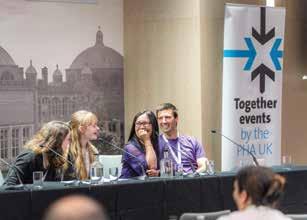

“PH can be isolating so it’s very good to meet people”like-minded “The highlight of the day has definitely been getting together with my PH friends”

“I’ve loved meeting lots of people that I’ve been chatting to on the Facebook group. It’s wonderful as it’s talking to another person that’s just like you!”

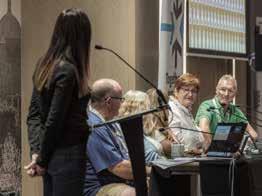
“It's the first time I've been to something where I've felt I'm really part of it and I'm really accepted”


“I want to say a huge thank you to the PHA UK for putting on such a fantastic day. We've really loved being here, being a part of it, sharing new information about pulmonary hypertension, and getting together with everyone!”
“It's been a very informative day. It's really useful to hear the other perspectives of people with PH and how it affects their lives and their partners”
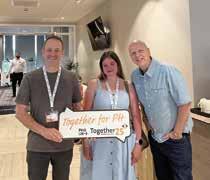
“I’ve come a long way to be here today but it’s been so good to get together with people with lived experience”

Our free self-help programme has been developed with psychologists specifically for people with pulmonary hypertension – and 100% of those who tested it said it helped with their anxiety. Based on Cognitive Behavioural Therapy (CBT)
Complete the workbooks at home
Work through them in your own time




Benefits Calculator
Find out what you might be able to apply for by answering questions about your personal circumstances. phauk.org/BenefitsCalculator
Grant Search
Discover what supportive grants may be available to you and your family. phauk.org/GrantsSearch
Personal Independence Payment (PIP) Helper
Walk through the PIP application process step by step, access tips and checklists, and more. bit.ly/PIPhelper
Tools provided by our partnership with Turn2us www.turn2us.org.uk
Lots of you shared selfies holding our photo cards. Here are a few from the lead-up to the day…

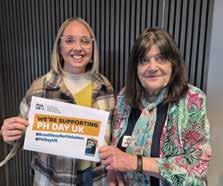

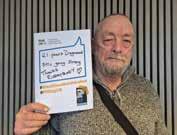
This magazine went to print just before PH Day UK, and we’re grateful to everyone who got behind our annual awareness initiative on 7th November.
With this year’s theme of #BreathlessNotVoiceleess, there were many ways for PHA UK members to get involved...
Our new awareness kits, including posters, leaflets, stickers - and information for GP practices - were ordered by a huge number of people. Thank you to everyone who made use of them in their local communities.
Our online PH Platform gave the opportunity to post public messages – including messages of thanks for the support of loved ones and NHS care, and requests for understanding and compassion from others.
We dedicated an hour of the day’s social media activity to celebrating little phighters (see page 63) and many of you contacted your MPs, using our template email to ask them to share information about PH with their online followers.
New for this year, we invited people to light candles of hope together at the same time. In homes across the UK,
candles burned at 8pm as a sign of unity, and for personal reasons that ranged from hope for a cure, to remembering someone special. Our PHA UK branded candles are still available to buy – see page 61 for details.
Finally, PH Day UK saw us launch the findings of our symptom burden study, along with new videos filmed with PHA UK members Paula, Nora, Emily, and Jayne. The statistics and films bring important attention to the impact of PH symptoms, and we’re grateful for the personal experiences shared on camera. You’ll find all the details on page 9
Check out our social media channels for news and photos from the day itself!
@PULHAUK
@pha_uk_insta


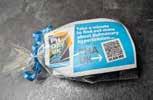


It was wonderful to hear about all your plans in the run-up to PH Day UK. We’d like to give a special shout-out to Jo Dunbar (pictured above), who came up with the fantastic idea of making 25 bath bombs and hiding them around her local town of Wrexham with postcards linking to information about PH. The concept combined making people smile with the surprise gift, whilst encouraging them to find out more about the rare disease. Brilliant!

An adventurous group of Virgin Media 02 colleagues trekked the Yorkshire Three Peaks in September, raising over £3,000 in memory of a special little boy.
Aidan Stanistreet lost his life just a day after his first birthday, and his
parents Nadine and Jacs, along with their friends and family, have since raised a huge amount for our charity in his name. The Three Peaks challenge saw Nadine and her colleagues tackle 24 miles of tricky terrain, wearing brightly coloured t-shirts emblazoned with Aidan’s photo.



A snapshot of some of the amazing fundraising support over the last few months
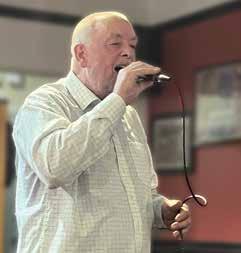
Hitting the high notes
PHA UK member Chris Johnson combined his love of performing with support for our charity by holding a busking night at his local pub in Barnsley. Chris regularly gets together to sing with friends, and he took the opportunity to raise both funds and awareness by dedicating a night to our charity.
When Hannah Talbot got married, she invited guests to make donations to our charity in memory of her father Richard, who died in 2009. Her special day with new husband James raised over £3,000.

Determined Jill Branch took on a trio of running challenges for us this year, completing the hat-trick just before her 70th birthday.
Two 10km events were ticked off in the spring, and in July she battled stifling temperatures and two unlucky falls to complete the Sherwood Pines Half Marathon in Nottingham. Jill, who has systemic scleroderma, was investigated for PH last year. Although she was found not to have the condition, she was so touched by the support she was shown that she chose to raise money to help others.

Supporter Sami Moghraby celebrated the life of his mother with some fantastic fundraising efforts over the summer. First, he was joined by family and friends for a colourful sponsored hike in the Shropshire Hills, and a few weeks later, he teamed up with neighbours to hold a garage sale which extended down the street. The thoughtful activities have raised over £3,600 and a lot of valuable awareness too.


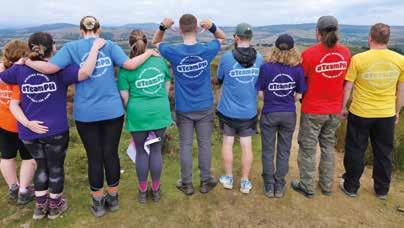
September saw PHA UK Chair Dr Iain Armstrong and PH nurse Javier Jimenez team up to take on a one-mile open water swim in support of patients.
Iain and Javier, a clinical nurse specialist at the Royal Free Hospital, completed the Swim Serpentine event in London’s Hyde Park – lapping the famous lake to raise over £2,000. Thank you to all the PHA UK members who supported them with sponsorship.



Over £1,300 was donated by a Darlington-based dance school, who dedicated their performance fundraising to the PHA UK.
The Tiffany School of Dance holds a hugely anticipated show every two years, with all students over the age of three taking part, and a charitable cause is chosen to benefit each time. Their office manager’s husband was diagnosed with chronic thromboembolic pulmonary hypertension (CTEPH) and underwent life-saving surgery at Royal Papworth Hospital – so our charity was chosen for 2025. The fantastic fundraising total was reached through selling raffle tickets and show programmes.
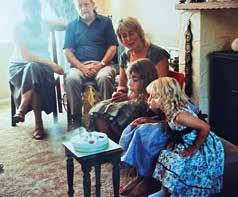

Whilst this magazine was at the printers, Ryan Beckett and Ella Bardsley-Taylor took on a 13.1-mile challenge in support of someone very special to them.
The pair completed the Run Tatton Park Half Marathon in Cheshire on 9th November, cheered on by Ryan’s fiancée and Ella’s sister, Jen. Jen, who was diagnosed with PH in 2024, shared her story in the last issue of emPHAsis – and she was pictured singing on the cover. At the time of going to print, together Ryan and Ella had raised an amazing £3,000 in sponsorship.
We are an independent charity with no government funding, so we rely on the kindness of our fundraisers to help us support people affected by pulmonary hypertension. From bake sales to bike rides, marathons to motor racingand everything you’ve seen in this feature - we’re
She's doing it…
“Through all the hard training, I’m hoping my Nan’s presence keeps me going.”
Lily-May Bailey will be spending the winter training hard for her first ever 26.2-mile run, having gained a ballot place for the world-famous London Marathon in April. She has chosen to raise money for our charity in memory of her grandmother, and she will be thinking of her as she builds up her mileage over the cold months ahead. “My Nan was the heart of our family and I miss her every single day”, Lily-May said. “She remained so strong, so kind, and I’m running because she never gave up."

constantly amazed by the lengths our supporters go to in our name. We are so grateful for every penny raised, and with summer in full swing there couldn’t be a better time to support us. Find out more, get inspired, or request your free fundraising kit, by clicking the button.

Winter can bring colds and viruses as well as festive joy – and along with PH medication side effects, the chances are you’ll be spending some time in your local pharmacy (or medicines aisle of the supermarket) over the next few months. But do you know which non-prescription medicines you should avoid or take with caution if you have PH?
This feature has been produced with expert input from the pharmacy teams at the Scottish Pulmonary Vascular Unit and the Sheffield Pulmonary Vascular Disease Unit.
Always speak to a GP, pharmacist, or specialist PH centre if you are unsure whether a medication is safe.
‘Natural’ sprays such as Olbas oil and SteriMar are all safe to use if you have pulmonary hypertension.
Some PH drugs cause blood vessels in the nose to be dilated, and this can result in nosebleeds. If there is any irritation in the nose, such as loose skin, it can cause the vessels to burstso using a saline spray reduces the risk of bleeds.
Steroid nasal sprays, such as Beconase, are also very effective at reducing nasal congestion but they shouldn’t be used for more than seven days.
Active nasal sprays, such as Sudafed and Otrivine, contain decongestants and should not be used for more than three days.
Decongestants in general should be avoided when you have pulmonary hypertension as they can make the blood pressure in the lungs higher. Always tell your specialist centre if you have used an active nasal spray.
If you have a dry nose due to oxygen use, you can buy lubricants to help, such as optilube and K-Y (these are also prescribable). However, it’s vital that you avoid products that contain paraffin, such as Vaseline, as they are very flammable.
Decongestants taken through the mouth (oral decongestants) should not be used if you have pulmonary hypertension. They contain pseudoephedrine and phenylephrine and can raise the pressures in your pulmonary arteries. These products include cold and flu relief products and off-the-shelf household names such as Sudafed, Day and Night Nurse, and Lemsip. If you are unsure whether a product contains pseudoephedrine or phenylephrine, please check with the pharmacist.
Paracetamol is the go-to treatment here, and it’s recommended you try this before anything else.
Non-steroidal ant-inflammatory drugs (NSAIDs), such as ibuprofen, naproxen and aspirin, are generally not recommended for people with respiratory conditions because they may make your breathing worse if they are used long-term. However, they are safe to take for very short periods (no more than three days), if you are experiencing acute pain.
Co-codamol is safe to take if you have PH, but it can make you feel drowsy, nauseous or constipated. Do not take paracetamol alongside co-codamol as it is already contained in the product.
Cooling treatments, which are applied directly to the forehead, can be used very safely if you have PH.
Products that neutralise acid in the stomach, such as Gaviscon, Peptac and Rennies, do not interact with PH-specific drugs but they do interact with many others. Check with a pharmacist that you can take it with your other medications.
Products that reduce acid in the stomach, like Nexium (esomprazole) can only be obtained over the counter.
Loperamide (commonly bought as Imodium) is recommended here, and there are no known interactions with PH-specific drugs. If you have loose stools for a prolonged period, you can risk becoming dehydrated. As someone with PH, it’s really important to get a fluid balance and it is possible that you will be taking diuretics (water tablets). Combined with loose stools for a long time, this increases the risk of kidney injuries, so please see your GP if you think you are becoming dehydrated.
There are no laxatives that you need to avoid if you have PH.
Steroid creams are used on small areas to treat rashes or mild eczema. These should not be applied to the face without medical advice because hydrocortisone, which is a weak steroid, can be an irritant. It can weaken the skin barrier if used for long durations or over large areas. Anti-fungal creams such as Daktarin have some interactions with oral tablets (although not PH-specific ones) so make the pharmacist aware of other medication that you’re taking.
Remember that ‘natural’ doesn’t always mean ‘safe’ so if you are considering taking a herbal medication, or a food supplement such as vitamins and minerals, always speak to your specialist team first.
You’ll find more advice on non-prescription medications and PH in our new leaflet. Order for free at phauk.org/MedicinesAndPH or click the button.



Make the most of your pharmacy this winter!
Pharmacies are a really valuable asset to our high streets, and you might be surprised to know just how much they can help you with.
Pharmacists are very highly qualified, you don’t need to make an appointment to speak to them, and many pharmacies are open during evenings and weekends too. Most of them have private consultation forms.
The NHS Pharmacy First scheme, launched in 2024, allows patients in England, Scotland and Northern Ireland to receive treatment for seven common conditions directly from a pharmacist, without needing a GP appointment. The service is also available in Wales, where it is called the Common Ailments Service
Pharmacists can now provide consultations and, if appropriate, prescribe medication for conditions like sinusitis, sore throat, earache, infected insect bites, impetigo, shingles, and uncomplicated urinary tract infections in women.
You can also access seasonal vaccinations at your local pharmacy, often without an appointment. If you have PH, it’s vital that you have had your winter flu vaccination, and some of you may be eligible for a COVID-19 vaccination too.
Lois Walker has a passion for travel, and she doesn’t let being on oxygen therapy stand in her way. Now 80, she spent the summer touring the UK with her husband and their faithful motorhome – enjoying the beauty of the East Coast of England and Scotland. Fresh from returning home, she shared her experiences and photos for other people with pulmonary hypertension.

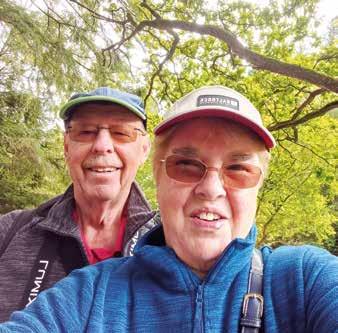
Wehave always loved camping holidays, starting in small tents, and moving onto caravans and motorhomes. The sense of freedom to do what we like when we like, whatever the weather, is important. And the planning of our holidays is one of the best bits.
So when I was diagnosed with chronic thromboembolic pulmonary hypertension (CTEPH ) in 2012 my husband Alan and I realised that our future holidays might take a little more planning! Within a few weeks of diagnosis and starting treatment, I was advised to use oxygen for several hours per day, and then latterly overnight.
This did not stop us going away in our motorhome. We purchased a portable concentrator to take away with us and worked out how we would set it up in the van, so that I could use it every night. Yes, it was noisy at first, and it kept us awake, but we quickly learnt how to muffle the sound in various ways – without causing it to give out those annoying beeping alarms!
Over the last 13 years we have travelled all over Europe, including taking my concentrator up the Jungfrau Mountain in Switzerland. We loved exploring Norway, including above the Arctic Circle, and France, Belgium, Germany, Austria, Holland,


Denmark and Sweden. Of course, we can’t ‘wild camp’ nowadays as we need a supply of electricity, but most campsites provide it on their pitches.
In August this year we decided to stay in the UK and explore the East Coast over a three-week period. We were travelling in our Bailey Adamo Motorhome, which we’ve named ‘Andre’. It is very comfortable and spacious, with a bed which lowers down from the ceiling, and a great bathroom and kitchen.
We first travelled from our home in Leicester to Bridlington, where we had great memories of past holidays when the children were young. We found the amusement arcade which we used to frequent and walked along the cliffs. Our next stop was Durham, which we didn’t know at all really. The city was delightful, and a walk along the river in the sunshine led us to the cathedral, which was everything we had hoped for. We also found time for a day out at the Beamish open air museum whilst we were there.
From Durham we travelled to Berwick-on-Tweed, where the campsite overlooked the estuary with great views. The local bus got us into the town, and we walked around the medieval town walls, and explored the narrow streets. Then it was on up to North Berwick in East Lothian, Scotland. This was a chance to walk over the sand dunes and explore the seashore. We also found several National Trust properties to visit including Newhailes House, and a very interesting dovecote (or ‘doocot’ as they call them up there!)
We then reluctantly turned south towards home again, visiting one of our favourite Border villages, Newcastleton, before spending a few days just outside Carlisle, where we always enjoy a wander in the forest behind the campsite.
Our last stop was in Knaresborough, of Mother Shipton fame! Andre took us 905 miles, and to seven campsites over 23 nights. Not bad for a pair of octogenarians!
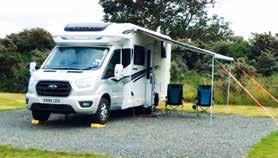


My top tips for travelling with an oxygen concentrator
If you’re going on holiday, especially abroad, remember these important things:
• Make sure the concentrator is working well and has been serviced recently
• Check you have enough prescription drugs
• Take spare oxygen tubing etc.
• Have up-to-date medical insurance
• Take your European Health Insurance Card (EHIC) with you
As a woman diagnosed with pulmonary hypertension, it can be devastating to be told you shouldn’t go through pregnancy – and it’s something many find difficult to discuss. To help others, PHA UK member Bisma Hussain - a counsellor who has lived with PH for five years - explains how she has come to accept her circumstances.
There is a massive difference between making a choice not to have children, and that choice being taken away from you.
I was newly married when I was told I had PH. I remember the consultant sitting my husband and I down and explaining there was a one in four chance of me not surviving if I gave birth. It was a really scary figure, and although it was hard to digest, I knew I couldn’t do it. Lots of things went through my head – should I have tried for a baby sooner? Should I have done this, or that, and
would that have changed anything? I went through all these different scenarios in my head, but I had to bring myself back to reality and decide on how to move forward.
It took a long time, probably around two years, to decide on our next steps.
We went down the adoption route first but got rejected because of my condition. It was frustrating because my husband's perfectly fit and healthy, and there are so many people who give birth naturally and then get ill, and they are still able to have children.
I strongly believe I would have given someone a really lovely home if they had given me the opportunity, but I had to accept that just wasn’t on the cards for me.
We then went down the surrogate route, so we were going to freeze my eggs, and then find a surrogate.
But that's not an option for everybody, and it was very, very expensive.
We were on the surrogate list for years and it got to a point where my husband and I both had to decide whether to continue or not. I was conscious of not getting any younger, I was in and out of hospital, and it just didn’t feel viable for me anymore.
I think what eased my mental health regarding the issue of having children was that I had the support of my husband with the decision. If he had been insistent on wanting children, it would have been a lot harder. Coming to a mutual decision took that weight off my shoulders.
Like a lot of women, I was raised in a household where it’s expected that you get married and start a family. It’s embedded in women from a young age that it’s just how your body is supposed to be.
So, when somebody tells you that your body isn't going to let you do that, there's a lot of self-blame. However, I'm also a big believer that everything happens for a reason and maybe it just wasn't the thing for me and I'm okay with that now.
Yes, it took time. You have to be kind to yourself, and you have to go through these emotions because it is a form of grief. You are giving up something - a child that you will never be able to have - and you have to mourn that. But once you come out the other end, it does feel lighter.

It took Paula Hartley a long time to accept her mobility scooter, but ‘Madge’ is now part of the family…
I was diagnosed with pulmonary arterial hypertension in 2007, and I was mortified when I had to start using a scooter a few years later. I was only 40 and I hated using it in public.
I stopped going to Meadowhall, the big shopping centre where I live in Sheffield, because I didn’t want to be seen. I’m a larger lady, so I felt uncomfortable about sitting on one because of what people might think.
I couldn’t walk around Meadowhall though, so I missed out on a lot with my family as they had to go without me. I was just too embarrassed about what I would look like, and if anyone I knew would see me.
For the first four or five years of having the scooter, it rarely went anywhere. I mainly used it when
we went on holiday, where I wouldn’t see anyone who knew me.
I don’t know what happened, but eventually I just realised that I couldn’t change my situation. There was nothing I could do about it, so I might as well use it to get out and do more.
These days, I go anywhere and everywhere with it. I’ve even named her Madge, and everyone always asks ‘are we taking Madge? Is Madge coming?’
It’s just normal now. My grandkids have bought me a number plate and they sit on my lap whilst I give them rides. Madge is part of the family, really.
The scooter has gone from something I had to have to something that enhances my life.

It enables me to go off and do a lot more things. It gives me freedom, as I can go off on my own.
Getting a scooter as a young person can be horrible as you think they are just for old people, but now I just go anywhere on it.
Would you like to share your own experiences of mobility scooters with readers of this magazine? Email media@phauk.org
When we launched our photography competition earlier this year, we didn’t know what to expect. Would there be much interest? Would the entries be any good? It’s safe to say we have been blown away on both fronts!
Your fabulous nature photographs have rolled in throughout the spring and summer months and each and every one has brought a smile to our faces.
With such a high standard of entries, our judges had a tough time deciding on a winner. In fact, they couldn’t agree on second place in the adult category, so we made the decision to award joint runner-up prizes!
The original plan was to publish the top ten in this magazine, but we believe they all deserve to be enjoyed - along with the beautiful captions
you provided - which is why we have displayed every single entry on these pages. You’ll already have spotted the winner on the cover.
As well as celebrating the talents of our PH community and encouraging people to get out into the natural world, this competition also raised hundreds of pounds for our charity.
Thank you to everyone who got involved.
The entries were judged by PHA UK Chair Dr Iain Armstrong, emPHAsis designer John Smith, and professional photographer Jules Nelson. After the winners, they are displayed in this feature in no particular order.
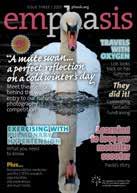




Read our interview with Nigel on page 58!
"A lovely mute swan, and a perfect reflection on a cold winter’s day."
Nigel
Our judges said: It was the symmetry and calmness of this image which made it the winning choice. The choice of a fast shutter speed kept the subject sharp, but Nigel still captured the motion in the water which hinted at the swan paddling beneath the surface. A striking subject with great composition. More overleaf >>>



"Taken in my parents' garden, this shot took patience and being in the right place at the right time. I love bees and to capture them doing their thing is always a pleasure."
Our judges said:
Technical knowledge and patience were what appealed to us about this image. It really gets close into the subject and would have been a challenging shot to achieve with such a fast-moving subject, where the smallest movement would take the bee out of frame.



"Feeding birds is part of my incentive to exercise when it's hard, and it's such a joy to see the baby birds hatch and grow"
Our judges said:
We loved the story being told in this image. Jo has beautifully captured a unique moment in time with the goslings arranged around the adult in what we could imagine was a noisy clamber for attention and safety.
1 2





(1) George Timberley
Bumble bee
"A beautiful bumble bee on a flower. Simply buzzing."
(2) Sarah Timberley
Watermill
"This watermill represents peace and tranquillity as I reflect and think about my beautiful mum."
(3) Elayne Coakes Teasel

"This is a photo my husband (who is currently under investigation for PH) took in our garden. We actively plant for bees and butterflies especially with wild plants like this Teasel'
(4) Lynda Darch Midnight sun
"Two young foxes, likely to be siblings, visiting our garden last July for water, birdseed and whatever else they could find." 4 5 6 3

"This was taken on our recent Norwegian Havila coastal journey, a bucket list holiday. It was taken at 6 minutes past midnight, so its midnight sun!" 7 8

(7) Clare Ledger
Flower droplets
(5) Susan Cook Common Darter
"I was walking on a hot sunny August afternoon last year and when I had a break on a seat, I noticed this Common Darter flying around. Then it came to rest on the waymark post. It was a thrill to see the intricate details, colours and fine movements."
(6) Susan Cook Lupins
"I was walking in Northumberland and found these Wild Lupin in full bloom. The clusters of flowers made a lovely scene with the bright blue colour."
"This picture really feels like me. I love how delicate the flower is, it's soft and beautiful but it still needs moisture to stay alive. It reminds me that even something gentle needs the right care to thrive, kind of like me."
(8) Charles Barker-Benfield
Pair of foxes



Jo Dunbar
(9) Lake in the park
(10) Flower in the park
"The park is one of my happy places."
(11) A country lane
"Getting out on my e-bike and exploring the area is hugely important to me for my physical and mental health, and nothing beats sunrise rides!"
(12) Charles Barker-Benfield Young fox
"This young fox was a regular visitor with her sibling and gave us great company during the summer."


(13) Nigel Wilson Jays
"The photo shows three jays. Getting out into nature helps me deal with this illness and forget it for a while. I just love to get out on my scooter with my camera."
(14) Nigel Wilson Butterfly
"A lovely peacock butterfly on white flowers of the blackthorn in the warming spring sunshine. It just makes me feel alive out in nature."

(15) Jane Barker-Benfield
Thirsty badger
"A thirsty badger taking advantage of a bird bath in our garden. A real privilege and joy to see."
Jamie Beglin
(submitted by Jamie's partner, Nicki)
(16) Memorial
"This is the War Memorial in Stornoway. It was a beautiful sunny period of the day with bright blue skies but the photo is deceiving as we had incredibly strong winds that day as well. It's kind of poetic in a sense that as PH’ers we can look good on the outside but it doesn’t show what we’re phighting on the inside and that things aren’t always what they seem at first glance."
(17) Calanais Stones
"This is a photo of the Calanais Stones. It has been on my bucket list for 35 years to go visit them and in March 2025 I finally got there."
(18) Brook
"We took a lot of photos during our Easter trip to the Isle of Lewis."
(19) Waterfall
"We always look for waterfalls, rivers etc. There’s something so calming about watching water, even when it looks stormy."
(20) Anna Bowen Red kite
"A red kite flying over my parents’ garden."


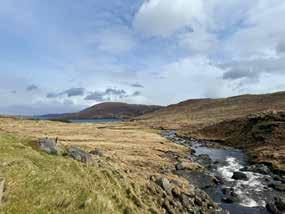



(21) Louise Colbourne
Nature reserve
"This is the landscape at a local nature reserve. I walked 8 miles that day which is an achievement."
(22) Myra Morrison
Shaded waterfall
"Captured on a recent short break to Devon area. A beautiful little waterfall in a shady area… sun filters through, and it feels so calm and peaceful here!"
Tess Jewson (23) Izzy
"Izzy is my companion. She means everything to me"
(24) Izzy and Paddy
"I wanted to enter both dogs to the competition. Izzy and Paddy are the best of friends. Dogs are amazing and help you through the ups and downs of life. To be honest I couldn’t be without my Izzy and when Paddy (who is my mum’s dog) comes to stay we have the best time together"


(25) Michael Moran Baker bee
"My photo is of a baker bee on lilac flowers on a lilac tree in my garden. I love bees due to their importance in nature and also for their constant hard work supporting their hive and their queen. They are also incredibly beautiful."
(26) Shazia Hanif Pheasant
"We kept peasants for few weeks during Easter, on behalf of a friend. I found the colours of this bird amazing. I would have my cup of tea in the sun and just watch these gorgeous birds and it was so pleasing'




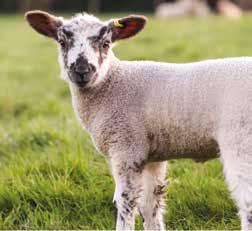





(27) Ella Soady Spring lamb
"An inquisitive spring lamb. A sign of hope and new life after a long, cold winter."
(28) Johanna Ferguson Scottish climb
"This was the view in Scotland after a climb with my 9-year-old son, it was hard work but worth it and showed that hard work pays off. We felt a great sense of achievement!"
(29) Katrina Clarke-Abbott
Barn owl
"I noticed this beautiful barn owl was perched on a tree whilst sitting in traffic. I lost my father 27 years ago and have always said he has come back as a barn owl. Whenever I am feeling troubled I see one. I was having a difficult time when I took this."
(30) Marzena Skoczek
Birds, trees and air
"I love birds because they are free and all the colours of the rainbow give me hope. Trees give fresh air to help me breathe."
Adam Drage (31) Lavendar inflorescence
"Taken in my parents' garden - a muse of mine - this image depicts a lavender inflorescence, backlit by the early evening June sun. On the theme of nature, this inflorescence covers all stages of the flowering plant in one; flowers in bloom, flowers yet to bloom and flowers that have already bloomed."
(32) Bleeding heart flower
"Taken on a visit to the beautiful Coton Manor Garden in Northamptonshire this spring, this picture is of the flowers of a Lamprocapnos spectabilis 'Alba'white bleeding heart - plant. With this being a heart-shaped flower and this competition being held by the PHA, it seems fitting for it to be entered."
We reserved two special prizes for photographs taken by someone under the age of 12. Well done to all the youngsters who submitted the wonderful images shown!

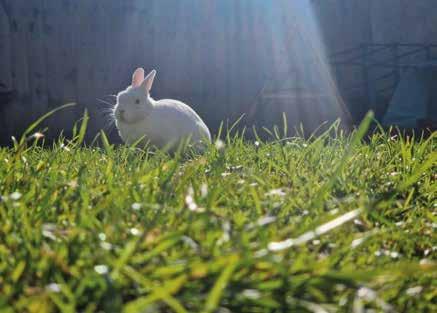

of the rabbit, the composition that splits the frame in half with the rabbit breaking the centre line, and the strong sense of depth are all excellent.
"It shows my rabbit in our garden. I was brave enough to carry her out of her hutch, and my mum said she could explore the garden if we kept an eye on her. I was so proud I managed to carry her which I had never done before, that I decided to take some photos to remember the moment. I managed to get this one and it is my favourite one of her caught in the sunbeam that was shining on the garden. We said that it was sent from heaven from her sister who we lost not long ago to illness."
Our judges said:
We were blown away that such a technically skilled image was taken by someone of Charlie’s age. The use
10-year old Charlie lives in Devon, and the photo is of his pet rabbit, Milkshake, who was sadly lost earlier this year. It was taken using his mum’s mobile phone.
How do you feel to be named the winner?
"I feel really happy and shocked since it is my first ever win in a competition."
What do you enjoy about taking photographs?
"The enjoyment of actually taking them with pure precision while lying down on the grass and getting the perfect view and detail for what the viewer would see. Also I had so much fun while Milkshake was running around the garden and when she was chasing me around, it made me laugh and giggle."




"This photograph was taken on a walk and we were watching the sunset. The heart shape is made by my little sister. The photograph means a lot because it shows the sunset but also sharing beautiful moments with family. My auntie has pulmonary hypertension and entering this competition means a lot. I wanted to show nature and how moments can be captured."
Our judges said:
We all agreed that this image is very creative. It’s a great sunset with nice texture in the clouds, but the hands silhouette and heart take this photograph to another level.
(33) Haley Carr Waterscape
(shot taken by Haley's daughter)
"My daughter was diagnosed with PH in July 2024 and has shown the most amazing courage and strength. Since spending over 9 weeks in total in GOSH she has a passion for taking sunrise pictures and pictures of the area we live in. She has opened our eyes too to take in the world around us, slow down and breathe for a second."
(34) Coco Praest Resting parakeet
"I took this photo when I was walking in my neighbourhood with my family. I saw the parakeet in a tree and it was really hard to spot. Parakeets are amazing to see."
(35) Aika Praest Jumping squirrel
"This is a squirrel jumping on the roof of our garden shed. I had to wait a long time to get the shot."



Everyone feels differently about Christmas, and for emPHAsis columnist Raya, it’s a time to make memories with family and enjoy the magic of London.
It’s almost that time of year again! My favourite time of year - CHRISTMAS! I thought I would have a look back on my favourite festive memories and traditions that me and my family have enjoyed…
Christmas has always been my favourite time of year, ever since I was little. I love the winter, the lights, the magic, the gifting, and just everything about it. My dad always calls me 'Little Miss Christmas', because I just get so excited.
Every year me and my family always try to fit in loads of fun throughout December. First of course is decorating! I would definitely do this in November if I could, but my mum always says that’s way too early, so I have to agree on the first weekend in December. We get the Christmas songs on, all the decorations out, and spend the whole evening putting up the tree and our favourite hallway fairy lights. Our house always looks so magical.
One of my favourite things to do this time of year is going into London and seeing all the Christmas lights. We do it every single year, and having my car and disabled badge is such a bonus because it means we can find little parking spaces around London if we want to get out for photos. But mostly we love being cozy in the car with blankets, driving around town with the Christmas music on. This is something that does not tire me out or make me cold – it is just something we can do at our pace on whatever day suits us.

Christmas time for me is about spending as much time with family as possible, as I love it when we are all together and making memories. Even though my mum and dad haven’t been together for years now, they still go above and beyond to make sure we are all together for Christmas. They’ve made sure of it since we were kids and I’m so truly grateful they have. Me and my brother have never had to choose between them; we get to see them both on Christmas and spend it all together. Although they do take turns to make the Christmas dinner!



dad comes over and we order a pizza and watch The Polar Express. This is one of our favourite Christmas movies. After the film, now that I’m older and can stay awake, me and my dad then love going to church for their midnight service. It’s so magical! We sing Christmas carols and light candles to welcome in Christmas. I just love it. Then coming home and getting into cozy Christmas pyjamas is the best.

Over the years we’ve had lots of Christmas traditions, some have changed as we’ve got older, and some new ones have been added too. A massive tradition of ours is on Christmas Eve, when my

I’ll let you into a little secret – once I’m home it’s time to get to sleep fast, because even though I’m 25, Santa does still come to visit and I wake up to a stocking outside my door.
I can’t wait for Christmas to come around again, although last year was definitely one of my favourites as it was me and my fiancée Jade’s first one together. Spending Christmas with family is the best, but also having your forever person there too is amazing. We loved every single second together!
Merry Christmas to everyone, and I wish you a happy healthy new year. See you in 2026!

“The telephone support I received was brilliant. The person I spoke to was really knowledgeable and empathetic. At a difficult time, with my husband’s PH worsening, the support was just what I needed and made me feel so much better”
Listening Line user, August 2025

You can now choose and book your call online, at a date and time to suit you. Click the button to find the next available appointment.
Our free supportive call service gives you dedicated time with a PHA UK team member to talk through any worries or concerns you have relating to your emotional or mental wellbeing.
The Listening Line is for all PHA UK members and their family and friends too. It can help with:
• Adapting to a diagnosis of PH
• How to talk about it with others
• Coping with changes
• Concerns about the future
• Worries about loved ones
• How to access supportive palliative care
• Loss due to PH
...and much more! Please note we are unable to offer personalised medical advice or make or expedite NHS referrals.
Find out more or book a call at phauk.org/ListeningLine
Would you prefer support by email?
Our e-support service provides advice and signposting, or ongoing emails to help you through a difficult time. Contact us at support@phauk.org – at any time of day or night – and we’ll get back to you within two working days. You’re not on your own.





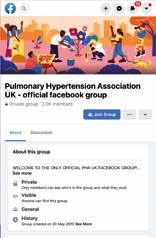
Our private Facebook groups are a valuable source of support and advice from people who truly understand. They are safe spaces to talk to other people with lived experiences of pulmonary hypertension. You need to have a Facebook profile in order to join these groups. Sign up at www.facebook.com. It’s free and easy!
We have dedicated groups for patients, carers, and loved ones too.
Click the button to access the groups, or visit phauk.org/SafeSpaces
Budding journalist Coco Praest is our Kids Corner columnist. For this issue, she looks back at a special school trip in the summer, that she was able to enjoy with PH.
Rafting with classmates
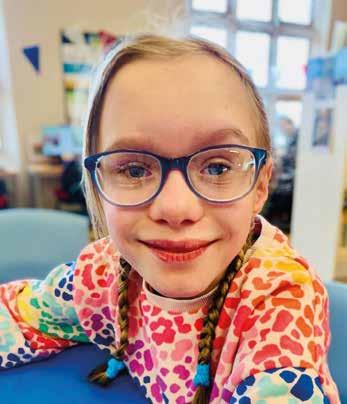

Near the end of Year 6 in June, we went on a school residential trip in Kent for three nights. It was really fun and my class and I enjoyed it.
We travelled from London by coach and it took about two hours to get there. When we arrived, we ate our snacks. Then, all the girls went to our spacious tent (the boys went to theirs too) to find our rooms and unpack. I shared a room with Aika and two other friends. After that, we did activities.
Coco is 11 years old and has been treated for PH since she was a baby. She has a twin sister, Aika, and they live with their parents in London.
One of the first activities was buggy building. We had to make a buggy using barrels, poles and rope. It was difficult because all the knots kept having to be tied and untied. In the end we rode on them. It was very exciting to be riding around on something you had helped build.

When it was bedtime, all the girls were very loud and messing about, which was strange because I thought everyone would be tired after the long day. It was very hard to sleep because of all the noise. The next morning we did problem solving skills. In one of them, you (and some other classmates) walk across a bridge made of planks. You needed to take one plank from the back and put it in front of you, so you can reach the end. Every time no-one is standing on a plank it gets removed making it very challenging. In another one, you and your group are on a giant wooden see-saw, which you have to keep balanced, otherwise it will tip sideways with a BANG! In the afternoon, we built rafts out of the same materials we used to build the buggies. The rafts had to be buoyant, robust and stable. We launched them into the lake and sat on them. I was in the middle and everyone else sat around me and rowed. It was very fun to float on the lake, so we stayed there for ages and ages. Later in the evening, we all gathered around a campfire, playing campfire games and toasting marshmallows. I was very tired after the busy day and fell straight to sleep. The following day we did an activity called the nightline, where everybody gets blindfolded and has to do an obstacle course.

While blindfolded, you are guided by a rope, navigating tunnels, paths, nets and (lots of) mud. It was extremely challenging because you had to rely on your teammates to get through obstacles. On reflection on the trip, I had a great time and took rests and breaks when I needed to. Some activities I couldn't do (like climbing ) but the ones I could do I did brilliantly!
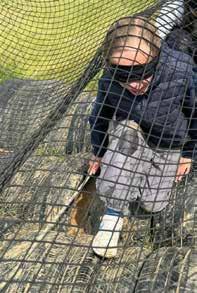


We have five hardback copies of Intergalactic Monkey Business, part of Jamie Smart’s brilliant Bunny Vs Monkey series, to give away to lucky readers. To be in with a chance of winning, simply answer the following question (the answer can be found in Coco’s column):
Q. Which three materials did Coco and her classmates use during their buggy building activity?
Email your answer to media@phauk.org with your name and address, before 17th December 2025. We’ll then select five winners at random. These brand-new books, which were only published in October, have been kindly donated for us to give away in the run-up to Christmas. Good luck!

Here at the PHA UK we’ve teamed with Great Ormond Street Children’s Hospital (GOSH) to build advisory groups to help the paediatric PH service and PH research. We’re looking for youngsters, and their parents / guardians too, to be part of this special network.
Annabelle Barnes of the PH research team at GOSH has written this message…
I work alongside the rest of the GOSH PH clinical team who you will know well, and many of you may have met me at GOSH either in the main hospital building, or at the Zayed Centre for Research (ZCR).
In collaboration with the PHA UK, we are setting up both a young person’s advisory group, and a parent’s, carers and guardian’s advisory group. This will be a place to share your ideas and opinions on PH research and the GOSH PH service. We are always looking at new projects we can undertake, and how we can make the service the best it can be, but as PH experts by experience, your voice is a powerful tool, and we would love to be able to co-create new ideas with you.
Our current GOSH PH newsletter began as a result of feedback from young people in the service, and I’ve also changed the way I explain the volume of research bloods thanks to a brilliant suggestion from a young person taking part in our research biobank! In these new groups, we might ask you to feed back on potential projects from doctors and researchers, support with the design of patient information tools, or to share your thoughts on current or future practice within the clinical service.
We want to hear from everyone – young people seen by the PH team at GOSH, those who have transitioned to adult services, and parents, carers, and guardians too. We plan to run the young persons and parent/guardian groups separately so that we can hear your unique and valuable perspectives. If you are a parent/carer/guardian and would like to only attend this group, or a young person only attending the young person’s group that’s absolutely fine – you can decide!
For young people it’s something for their future CVs, but for everyone we hope it is a place to have your say, and to connect with others in the PH community. We hope that this will be a regular forum, but there is no commitment to attend every time.
I’m always happy to be contacted to chat further, or to answer any questions. You can email me at annabelle.barnes@gosh.nhs.uk. We hope to see you in the group!
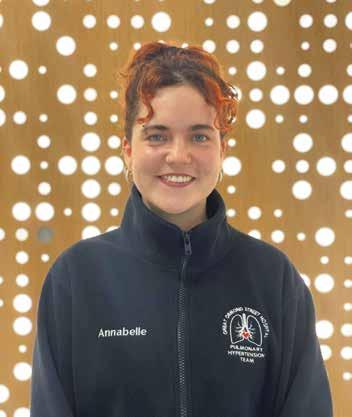

Please click the button or visit phauk.org/GOSHgroup to complete the form and we will contact you with further details.
This is your chance to help shape the future of care...
Here at the PHA UK we’re working with medics and researchers to ensure patients are at the centre of chronic thromboembolic pulmonary hypertension (CTEPH) service development.
CTEPH is the only type of PH that may be cured – through pioneering surgery called a pulmonary endarterectomy (PEA) or sophisticated procedures called balloon pulmonary angioplasty (BPA). It can also be treated, although not cured, via medication. Some patients may receive a combination of these treatments.
Whilst this treatment landscape has progressed, with many options now available, there has been limited patient and carer engagement on preferences – and this needs to change.
This collaborative project aims to put patients at the very centre of the decision process, with the aim of helping to shape UK NHS service development over the next decade and beyond.
We want to know what matters to you and your loved ones when it comes to making choices about treatment, and what influences those decisions. We want to make sure your voices are heard.
Who are we looking for? This study project is for UK-based patients who either have CTEPH, or who have had it previously (and have undergone treatment).
We are also interested in hearing from caregivers and loved ones, as we know that this disease affects the people around the patient too.
What’s involved? As part of this project, you will be invited to share your thoughts and experiences via surveys and focus groups. No commitment is needed; you can choose which opportunities to engage with through the duration of the study.
“We are excited by the opportunity to help bring the voice of patients and carers into the conversation about what represents the very best treatment we can offer in the UK. Doing this will help ensure that patient voices are heard as national services evolve and change.”
Dr Mark Toshner
Associate Professor in Respiratory Medicine, Royal Papworth NHS Foundation Trust Please click the button or visit phauk.org/CTEPHcare to register your interest and we will be in touch when the study begins.

Living with a chronic condition like pulmonary hypertension (PH) brings its unique set of challenges. But here's something you might not have given much thought to – the silent heroes of your body: your bones and muscles. Let's chat about why they deserve your attention and how you can keep them strong, especially when managing ongoing health conditions. Think of your bones and muscles as your body's dynamic duo. Your bones aren't just a rigid framework; they're living tissue that protects your organs like a well-designed suit of armour. As for muscles? They're not just for showing off at the gym – they're essential partners in everything
By Shaun Clayton, Certified Nutritionist and Operations and Finance Director at the PHA UK
from getting out of bed to maintaining your metabolism.
When you're dealing with a chronic condition like PH, these faithful allies can face extra challenges. Maybe you've found yourself less active than before, or perhaps you're taking medications that might affect your bone strength. Don't worry – I've got your back with some practical solutions.
Let's talk nutrition first. Your bones and muscles have quite the appetite for specific nutrients and feeding them right doesn't have to be complicated. Calcium is like your bones' best friend, and you can find it in more places than just a glass of milk. Love your greens? Kale and spinach are packed with it.
Fan of fish? Sardines and salmon, especially when you eat the soft bones, are calcium goldmines.
But here's the thing – calcium needs its buddy vitamin D to really work its magic. Think of vitamin D as your body's calcium chauffeur, helping it get where it needs to go. While sunshine is a great source, you can also find it in fatty fish, egg yolks, and many fortified foods. And let's not forget about protein – it's not just for bodybuilders! Your muscles need it for repair and maintenance, and surprisingly, it helps your bones stay strong too.
Moving your body matters just as much as feeding it right. Now, I know what you might be thinking – "Exercise? With my condition?"




Remember, you're not just maintaining bones and muscles –you're investing in your independence, mobility, and quality of life...


But here's the good news: movement doesn't have to mean marathon training. For those managing PH, gentle activities like swimming or modified yoga can work wonders. The key is finding what works for you, at your pace, with your specialist team’s blessing.
Here's a tip that often gets overlooked – hydration and sleep are like the background music of your health symphony. They might not be the stars of the show, but without them, the performance just isn't the same. Good hydration keeps your muscles happy, while quality sleep gives your body time to repair and rebuild. Living with a chronic condition doesn't mean you can't maintain
strong bones and muscles. It just means being a bit more strategic about it. Work with your healthcare team to create a plan that fits your life. Maybe start with small changes –adding an extra serving of calcium-rich foods to your meals, or trying gentle stretches in the morning.
Remember, you're not just maintaining bones and muscles –you're investing in your independence, mobility, and quality of life. And that's something worth protecting, one small step at a time.
What small change could you start with today to support your bone and muscle health? Sometimes the smallest adjustments make the biggest difference in the long run.
Find more advice on nutrition and PH by scanning below. In this dedicated area of our website, you’ll find information on:
Eating to manage the side effects of PH medication...Ultra-processed food...Managing a reduced appetite...Making one-pan meals with PH...Understanding calories... and much more!
Show that we are stronger together with our stylish new clothing range





Ease cold air breathlessness by pulling this neck tube up over your mouth.
✓ Hoodies ✓ Sweatshirts
✓ T-shirts ✓ Beanie hats
Keep warm and raise awareness of pulmonary hypertension whilst supporting our charity. From just £15! Sizes up to XXXL 20% from every sale goes directly to the PHA UK All includepricesP&P!
Our UNITED collection, in different shades of purple, is still available too!

Order now by clicking the button or visiting www.phauk.org/merchandise




At 81, Nora Green isn’t letting her age or her health conditions get in the way of having fun. Diagnosed with PAH in 2023, the great-grandmother from Greater Manchester has now found new ways to enjoy making memories…

Read Nora's story overleaf >>



I spent decades going to the gym, and even just a few years ago I was known as the ‘queen of squats’ there. Just before I got ill, I was working with a trainer, and he was coaching me to do 80 squats and 80 press-ups for my 80th birthday, to raise money for charity. Everyone would joke that my real age was 34.
Getting diagnosed with chronic pulmonary obstructive disorder (COPD), and PAH just a couple of years later, was life-changing. I think for the first year afterwards I just sat around waiting to die. I was always at the gym, but now all I could do was buy plants, knit, and learn cross-stitching. And when I was told I had to start on oxygen therapy it felt like the end of the world.
I’m not sure what changed - maybe I just got bored - but I eventually started to try and do more. And although it’s taken time, I’m beginning to accept things.
My husband Sean is 13 years younger than me and although it isn’t the
retirement together that we imagined, we still do a lot together. We go for regular short UK breaks, and on lots of day trips. Whenever the weather is nice, we make sandwiches and get out for the day.
I’ve got a shopping trolley that Sean converted for me to transport the oxygen canister on and that’s made things easier. It goes everywhere – including along beaches, and through fields. It’s fantastic on rough ground as it’s got rubber wheels. It was a great idea of his.
I’ve stopped letting things hold me back. Last year, Sean and I went to the coast for the day and I wanted to paddle, but I didn’t know what to do about my oxygen. I think I just decided ‘that’s it, I’ve had enough’ and took my trolley into the sea.
Now I paddle all the time. I'll lift my dress up and I'll walk into the sea and Sean will stand there with his eyebrows raised saying, ‘watch your oxygen’. I’ve always been too independent.
We’ve been married for 42 years, and he is very supportive. He does a lot of the housework, but I still do all the cooking. And I do a lot in the garden, but I know I

Nora doesn't let her oxygen trolley stop her paddling in
With

I think once you accept you’ve got this condition; you’ve just got to get out and make the most of life.
tend to do a bit too much. I’m still trying to get used to my limits and it can get frustrating. Losing independence has been hard to cope with.
There’s no getting away from the fact that my health conditions have had a big impact on being able to travel. Being on oxygen adds even more onto the high insurance costs, and at 81, with a few things wrong with me, a luxury holiday is cheaper than the insurance for it. But we enjoy our UK breaks, and getting dressed up for dinner. We get some good mid-week deals through Warner Leisure (who operate adult-only hotels).
Although I get frustrated about not being able to drive and having to rely on Sean to



help me get to a supermarket, there are still things I can do alone. I do a lot of walking around the local area with my oxygen trolley. I’m a Neighbourhood Watch co-ordinator, meaning lots of people always stop me to report things and ask questions, so it can take ages for me to get anywhere!
It's not been easy but I feel I’m slowly going back to ‘normal’, and Sean and I are out as much as possible now. What’s the point in staying inside knitting if I can be out doing something?
I think once you accept you’ve got this condition; you’ve just got to get out and make the most of life. Life is for
Nora has recently completed a 25-mile sponsored walk to raise over £1,000 for our charity. Taking on our #25in25 challenge, she covered a few miles each day with her oxygen trolley – raising awareness of PH along the way. Read about more #25in25 challenges on page 67.
'It’s ok not to feel ok about Christmas' says psychotherapist Sophie Papageorgis, who lives with pulmonary hypertension herself.
Christmas is generally considered to be a time of joy and celebration – spending time with family and friends, maybe reflecting on religious and spiritual meanings, and creating memories to cherish. However, when time of year.

For all that it started as a religious festivity, often Christmas can now feel more about presents and socialising – and this can feel tricky when you’re balancing life with PH. Trying to manage invitations and meeting up with others, pressures from family, and looking after your wellbeing, can be a bit of a balancing act. This can also create a bit of stress financially, especially if we’re not able to work, or don’t have too much spare money at the end of the month. Factor in other considerations, like going present shopping in busy times, and potential expectations to host or to travel, and it can get pretty exhausting and feel overwhelming.
The emphasis is often on seeing the magic in children’s faces, visits to Santa’s grotto, his overnight delivery down the chimney, and the presents and food for all to enjoy. It can be absolutely lovely to see. And it can also be quite upsetting for those of us who can’t have children,
or perhaps do have children but don’t feel as able to keep up and be ‘the fun parent’. Christmas marketing tells us repeatedly that it’s all about the fun and festivities with family, friends and children, which can sometimes leave us feeling a bit left out or different.
I am very blessed with some lovely godchildren, but I can’t pretend that my heart doesn’t sink when I hear the words, “can we go see the Christmas lights?" I would love to be enthused by this, and for all that I am a bit Scrooge-like on occasion, I do like the pretty lights! What I (or rather, what my lungs) don’t like, is walking around in the freezing cold, getting progressively bluer and more breathless, and trying to put on an excited face to help add to the magic for the children. Other considerations include trying to maintain a healthy(ish!) diet and managing alcohol intake, at a time of year when there is so much emphasis on food and drink. It can be somewhat frustrating.
But living with PH doesn’t mean that you can’t enjoy Christmas! Maybe it just needs to look a little different for us sometimes. Prioritising what’s important means that you can still experience the festive joy and create memories, maybe just at a slightly different pace. Who says we can’t create our own traditions (traditional Christmas Day afternoon nap, anyone?!)
Many people enjoy a nice crisp walk on Christmas Day morning (personally, I do not). If you go for a walk, perhaps factor in things like many layers, gloves, hats, and a scarf/snood that you can pull over your mouth, to keep warmer on a December day. Take breaks if you need to – not just on a walk, but at all times. Your loved ones won’t want you to feel exhausted and unhappy at Christmas, and prioritising your health is vital. If you’re more like me and prefer to be indoors, maybe suggest sedentary activities together, like watching Christmas movies, doing a snow-scene jigsaw, and listening to festive songs.
It can feel a bit of a faff needing to plan ahead, but it is important that we are able to put in rest breaks, keep up with our medications and treatments, and stay hydrated. Sometimes it might feel difficult to tell loved ones how we’re feeling, and we may want to ‘protect’ them or not seem like we’re putting a dampener on things. However, communicating with them means that they will have a greater understanding of how to support us, whether it be that they do most of the driving/travel arrangements, or you agree to avoid going to particularly busy or cold places. It may be worth moving your Christmas shopping online to save a few manic trips to the shops, or crafting personal gifts and cards to keep costs down.
There may be a few limitations and considerations, but Christmas is meant to be a time for celebration and joy, not intense pressure. By pacing ourselves, being open with others, and creating our own new traditions, we can still
can still have a
have a lovely festive season, even while coping with PH. After all (cliché incoming!), the best gift we can give ourselves and our loved ones, is our health.
If you’re struggling at Christmas…
“Christmas can be a tough time of year for anyone, regardless of whether or not they have PH. The financial strain can take its toll on anyone, feeling the need to provide gifts, food, alcohol, decorations, travel, and so on. This can lead to a lot of stress, and feelings of guilt if you don’t feel able to meet the demands or expectations from yourself and others.
Spending time with family can be difficult (I speak for myself here!). You can’t pick your family, and you can’t pick your in-laws (enough said…!). Family politics can be difficult to navigate, and spending a ‘joyous’ day with people you wouldn’t generally choose to hang out with or have conflicts with, can add to the stress of Christmas.
Loneliness often feels heightened around Christmas time, with a big emphasis on connection with others. All the adverts and marketing are aimed at the family unit, and spending time socialising with friends and co-workers. If we don’t have this network around us, or if we have recently lost a loved one, the feelings of grief and isolation can be intense to manage. Mental health struggles like anxiety and depression can feel heightened at Christmas, with all the changes in routine and expectations of ‘joy’.
For all that Christmas can be a wonderful time of year, for some it can be complicated and emotional. Try to do things that you enjoy, whether it’s watching some non-Christmas related TV, getting outside, doing puzzles, reading a book, learning a new skill, baking or cooking – anything that boosts your mood.
Treat yourself to something nice, which could be having some of your favourite food, a day in your pyjamas, or some pampering time. Perhaps avoid social media, where people will post what they want you to see, which can increase feelings of loneliness. Please remember that you’re not alone, and if you need to reach out for some support then there’s always people who are there to listen.
These organisations offer telephone support 24 hours a day, 365 days a year - including on Christmas Day:
• Call The Samaritans free, day or night, on 116 123
• If you’re feeling lonely or isolated, the Silver Line Helpline, run by Age UK is a free, confidential telephone service for older people. Call free at any time on 0800 470 8090
• If you are experiencing a mental health crisis, please call NHS 111



Nigel Wilson swapped leathers for lenses when he was diagnosed with PAH, taking up photography in place of motorcycling and learning to love a slower pace of life. His winning entry into our competition graces the cover of this magazine, and we caught up with the 66-year-old to find out what capturing nature on camera means to him…
Q. Thanks for chatting with us, Nigel – and congratulations on winning our competition! Can you tell us a bit about the man behind the camera, and why you entered?
A. I was diagnosed with PAH in 2018, which is connected to scleroderma and sarcoidosis, and that’s when I came across the PHA UK. I don’t normally enter competitions, but I wanted to support the charity, so I entered three different photos to give it a go. I never expected to win!
I took the image of the swan at the beginning of this year, in January. I live in Retford, near Nottingham, and I’m very close to a big country park, called Clumber Park. I visit it often to take photographs, and this one was taken on the lake there.
Q. Your motorcycle was replaced with a mobility scooter too, wasn’t it. How does that help you find good photography opportunities?
A. The scooter has made a big difference to me. I didn’t want to accept it at first, but I was forced to use one on holiday in the Canary Islands and I realised how helpful it was. It helps me get around at the National Trust sites where I do a lot of my photography.
Q. What is it that you enjoy so much about taking photos?


Q. What equipment did you use to capture the photo?

A. It was taken with a Nikon Z6ii, with a 180-600mm lens.
I didn’t need to wait very long to get the image. There are quite a few swans around that part of the lake, and it was a shaded area in the late afternoon of winter, which is why it looks so dark. I was surprised and happy when I received the email to tell me I’d won the competition. And having my image on the cover of the magazine tops it off as I’ve been receiving it for quite a number of years now.
Q. Have you always been a fan of photography?
A. It’s something I took up after I got ill and went onto the oxygen. My previous hobby was motorcycling, but it became very difficult. Just getting ready, and putting my leathers on, was making me breathless. I did try to go out on the bike a couple of times with my oxygen concentrator on my back, but it just wasn’t the same.
My son was into photography so I started going with him and it helped me to get out of the house. I invested in a better camera rather than using my phone, and that was four or five years ago now. Now my son and I take photos together weekly, often at National Trust sites as we are members.
A. It helps me to forget all the issues around my health and to get out in the fresh air. It gets me out of the house and into nature and it helps take my mind off things. It’s just me, my camera, and my scooter. I do enjoy processing the photos afterwards too, but I don’t use any fancy software, just an app on my phone called Lightroom (by Adobe). I use it to make small enhancements, but I generally try not to alter my photos too much.
Q. Are your photos just for you, or do you share them with others?
A. I post the odd one on a local Facebook group and every now and then I will share on the PHA UK private Facebook group in the hope it makes someone smile. If it cheers somebody up, even if it's only for a few minutes, then it's worth it.
Q. Will you be continuing to take photographs through the winter?
A. Definitely. I retire in November, so I can be spontaneous – if I wake up one day and the weather is good, I can get out there.
Most of my photos are of nature but I also enjoy capturing aircraft. On very cold days, or in bad weather, I drive out to the Royal Air Force station in Lincoln (RAF Waddington) and sit in my car while I wait for them to come over. It’s ideal.
Q. All three photos you submitted to the competition were excellent. What’s your personal favourite, from all the ones you have ever taken?
A. I think it’s one I took just last week, of a kingfisher (pictured opposite). It’s my favourite little bird to see as you don’t often spot them.

Nigel enjoys taking aircraft photos as well as nature

I was sitting on a little bridge, which is just five yards from where I park so very easy to get to without my scooter. I waited for around half an hour for a good photo opportunity, and just as I was thinking of giving up, this blue flash flew over my shoulder and landed in the perfect spot for a photo. It’s my favourite image in a long, long time and it’s one I shared on the PHA UK Facebook group. It was nice to see the lovely comments.
Q. Finally, if anyone has been inspired to try photography after reading this issue, what advice would you give them?
A. Well firstly I’d say you don’t need an expensive camera. You can take really, really good photos with mobile phones these days. I think it’s just a case of getting out there and giving it a go. Don’t put any pressure on yourself; you could start by photographing a plant in your back garden, or some flowers you spot on a walk. It doesn’t really matter what you capture, but it helps you really see and appreciate what’s





Turn to page 32 to enjoy all of the photos that were submitted to our nature photography competition.

The PHA UK is your charity, and we welcome your feedback on everything that we do, to ensure we are the best we can be. We’d love to hear your thoughts- good or bad - about any of our services, or about any aspect of our website, publications, or resources. In fact, we’d like your feedback about anything at all!
Click this button to leave your feedback via our online form (where you can remain anonymous if you wish). You can also email feedback@phauk.org
These PHA UK branded candles, emblazoned with the word ‘Hope’, are a special way of bringing light into your home during the dark days of winter. Presented in a glass jar with bamboo lid, the vanilla-scented candles provide up to 8 hours of burn time. They cost £10 (inc P&P) and £3 from each sale goes directly to our charity.
Order now at phauk.org/candle or click the button





Subscribe now at
or click the button
Our new self-help programme is available now
Developed by psychologists, and supported by the PHA UK, this is the world’s first self-help programme for people who live with pulmonary hypertension alongside depression or low mood. Complete the series of workbook over four weeks, in your own time and from your own home, and learn how to change your thinking habits and behaviours. The programme is based on cognitive behavioural therapy (CBT) and 87% of those who completed it as part of a controlled trial rated it as ‘good’ or ‘excellent’.



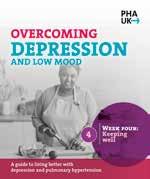
Find out more or order for free by clicking the button or visiting phauk.org/HelpForDepression
“It taught me how to change my negative thoughts and reactions to adverse situations”
“I was able to make this journey on my own in the privacy of my own home”
As part of our PH Day UK activities, we asked you to share the special young phighters in your life. Here are a few of the inspirational children you told us about…
Mum Jillian told us: “Florence has a chromosome 17 deletion resulting in interstitial lung disease and pulmonary hypertension. She has fought hard every day of her life and she is amazing and happy despite everything. She loves playing with her big brother and also loves being outside, playing on swings, music, and crisps! She is an incredible girl and we are so proud of her.”


Mum Jane told us: “Connie continues to amaze us every day. She takes everything in her stride and does not let her limits define her. If anything, she pushes past them and defies all expectations – something she has done since her diagnosis at the age of three. She has just started secondary school and is loving this phase, taking every opportunity to live life in all its glory – from gymnastics to school productions, new friends and new experiences. We are so proud of the gorgeous, kindhearted, resilient, determined version of our monster that she is becoming.”
Mum Melanie told us: “Daisy was diagnosed with PH aged one and I remember feeling so terrified about what the future would hold for our perfect little girl. She’s now six and is thankfully stable. Every day she makes us smile and laugh and she has this magical presence about her which just draws everyone in. She truly is amazing in every sense of the word and we couldn’t be prouder of her. Daisy absolutely loves going to school, has lots of friends and is progressing beautifully. She is our miracle!”
Friend Tess told us: “I first met Emily in 2019 at a PHA UK conference, after getting to know her lovely mum, Lorna. We've kept in touch ever since, and through our shared PH journey, Emily and her family have become wonderful friends. What makes Emily so special is her incredible strength, positivity, and passion for life, despite the challenges she faces with PH. From the very first time I met her, it was clear that her musical talent, kindness, and determination shine through in everything she does. Emily faces every obstacle with a smile and never lets her condition define or limit her. Our friendship means so much to me. Emily’s positivity, courage, and love of life are inspiring. She’s an amazing young lady who reminds us all just how strong and resilient young people can be.”
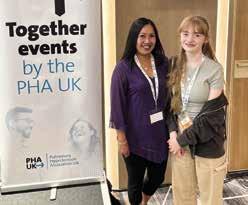
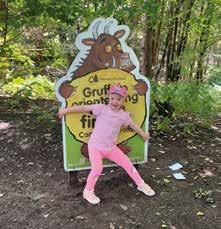
Emily and Tess are pictured together at our Together25 event in Birmingham.
If you’d like to see a little phighter you know in a future edition of this magazine, please email a few details and a photo to media@phauk.org
At 25 years old, Pooja was shocked to discover she had congenital heart disease – followed swiftly by a diagnosis of PH. She spoke to emPHAsis in July, just a few months after being told about her health conditions…
Ihad lived with a hole in my heart since birth without ever knowing about it, until the start of this year. I was always a child that never liked walking, and my parents just assumed I was lazy – which is what I thought myself for a long time. When I was 16, I got into fitness and started doing a lot of cardiovascular exercise, which didn’t cause me any problems until I got COVID-19 in 2022. It affected my breathing, and after I’d recovered from the virus, it still felt different. The exercise I was able to do before suddenly felt harder and even going up the stairs started to become more difficult. I didn’t think that much of it until I was on a staycation in Winchester with my friends in November last year. It’s a hilly city and two of my friends, who both have asthma, pointed out my breathing sounded worse than theirs. They encouraged me to book an appointment with my GP so as soon as I got home, that’s what I did.
He didn’t seem worried because my heartbeat was normal and I told him I
I can really recall from the conversation. Since then, life has been about trying to adjust to both diagnoses. I don’t think I’m fully there yet, but slowly I’m trying to get there.
I was told about my heart condition on January 17th and I remember the date as it was just a few days before starting my new job. I was so worried about what it would mean but my new manager was really supportive. I felt ok with everything, but then when I got told I had pulmonary hypertension the worry really set in.
that doesn’t make sense to most people. It means I must re-evaluate a lot of plans I have with friends, as I know I can only manage a short amount of time at social gatherings. And if I do something one day, I have to take the following day to rest. Planning is difficult, because
“My dog, Dwight, seems to know when I’m struggling”
I don’t know how I will feel from one day to the next, and again, that’s hard for people to understand.
“For 25 years there was nothing that would make anyone suspicious that I had a hole in my heart”
was exercising, but he agreed to a blood test and chest X-ray to reassure me. These tests showed the right side of my heart was working too hard and I had lung pressures, so I was referred for more investigations. I had a CT and MRI scan just before Christmas, and in January, it was time for an echocardiogram. The day afterwards, I was told I had a large hole in my heart.
More tests followed over the next few weeks, and I was eventually sent for a right heart catheterisation. I had no idea what the procedure even was, and when the consultant then told me it showed I had pulmonary hypertension, I didn’t know what that meant either. I just remember hearing the words ‘there is no cure’ and being told it advances, and the last resort is a lung transplant. That’s all
I’m on dual therapy - both taken as tablets - and that seems to be helping. The mental aspect of having PH has more of a strain on me than anything physical though. I do speak to my family and friends about how I feel but it’s hard for others to understand when they are not going through it themselves. I work mostly from home, which helps in terms of managing my symptoms. I was working as a waitress before this, and it was very difficult as I was on my feet and often the only person serving an entire restaurant. My job now is demanding, but in a different way. It gives me a routine and keeps my mind off other things.
My managers and someone in HR are the only people at work who understand the in-depth details of PH. I just tell everyone else that the pressures in my lungs are very high and that affects my everyday life, and I give some examples of symptoms.
The biggest symptom I experience with PH is exhaustion. This can be brought on just by concentrating or standing up for a long period of time, and it’s difficult trying to maintain the energy that other people in their twenties have.
When I get exhausted it impacts my breathing and can bring on chest pains. The fatigue goes alongside the exhaustion. It doesn’t matter how much I sleep; I wake up already feeling tired – and
I do enjoy spending time with my friends though. I take the train to see them in London when I can, and we do things that aren’t too hectic. We will find somewhere to sit and catch up, often in a restaurant.
Resting definitely helps me, and I try to live life at a slower pace. I read a lot, and I enjoy being in nature. I’m quite reserved anyway, and I’ve never been a night owl, so the PH diagnosis hasn’t massively changed my lifestyle. It has, however, made me worry a lot about the future.
Being with my dog, Dwight, has helped me deal with everything. He is a chocolate flat-coated retriever, and he seems to know when I’m struggling. With everyone else he’s hyperactive, but he’s different around me. Even before I knew what was wrong, he’d look back at me whilst we were out walking as a family. It was like he just knew, even when no-one else did.
One of my nurses told me about the PHA UK. I watch a lot of the charity’s videos, which show other people talking about their experiences. It helps because I'd never heard of this condition before. I follow other people with PH on social media and that helps too as I know I’m not alone with the diagnosis.
I wanted to share my experiences in this way because PH can be so misunderstood compared to other diseases, like cancer. It’s an invisible illness so more people telling their stories can only be helpful.
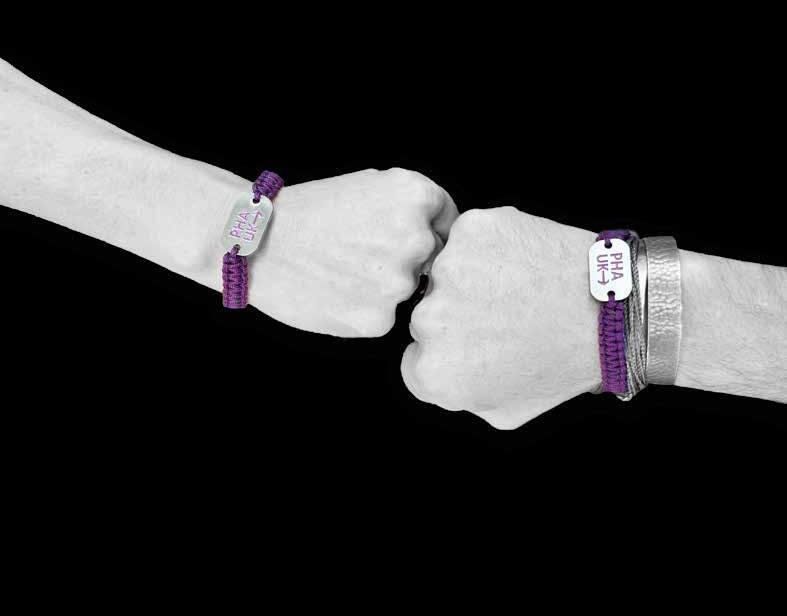



Thank you to everyone who has helped us celebrate our 25th anniversary in 2025 by taking on a #25in25 fundraising challenge. You’re all amazing!
My Chairman’s Challenge invited you to turn the number 25 into something uniquely your own, and it’s been wonderful to see the creativity, passion, and determination you’ve brought to life. Every penny raised (and every smile along the way!) means so much to the team here at the PHA UK. From imaginative ideas to touching acts of kindness and inspiring displays of resilience, every challenge is an example of how special our PH community is. You’ve reminded us once again that we are always stronger together.

A snapshot of what some of you got up to - and what you still have planned!
Nora Green didn’t let her oxygen canister get in the way of completing her challenge – she took it along on a converted shopping trolley instead. 81-year-old Nora walked 25 miles over a period of weeks, clocking up the steps around her local neighbourhood and during days out with her husband. Hear more from Nora on page 53.
Myra Morrison combined her kitchen-based challenge with two thoughtful acts of kindness. She baked 25 buns, donated them to her local care home, and then made a £25 donation to our charity.


Lou Chadburn walked for 25 minutes every day for a week, clocking up the miles during her lunch breaks. Lou, who has chronic thromboembolic pulmonary hypertension (CTEPH), tracked each walk using an app and snapped photos of her surroundings along the way.



CathyGavin ofisdoing25mins dayexerciseevery Novemberfor25daysin
Roy Dewar walked for 25 minutes every day for 25 – covering well over 350,000 steps. Roy, who lives with PAH and turned 81 in October, was determined to complete the challenge before his birthday.



Mary Ferguson (emPHAsis editor and PHA UK team member) has spent the year ticking off 25 running event challenges – with 22 completed at the time of this magazine going to print.


Jacqueline Calvert took 25 photos of waterfalls during her holiday in the OuterScotlandHebrides,
Stephanie Wolfe is cycling 25 miles in November
The mixture of marathons, half-marathons, 10ks - and even a 33-mile ultramarathon - have taken her around the UK (and caused more than one or two blisters!)

Jane Barker-Benfield is spreading her walking challenge over a full year in order to appreciate all four UK seasons. She’s completing 25 ‘wellbeing walks’, keeping a sketchbook, journal and photo album record and taking inspiration from spring, summer, autumn, and winter. Jane told us she is already feeling the mental health benefits of having the initiative to focus on, and she will be fundraising throughout. The photos shown, right, were taken during her first wellbeing walk in September, at a local RSPB reserve.


Kind-hearted Penny Thomas completed 25 different and very thoughtful challenges over her school summer holidays, raising over £900. Her outstanding efforts were all in support of her 12-year-old cousin Quinn, who has PH.
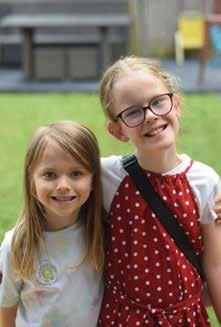
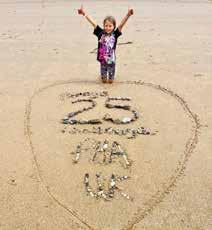

1 Walk 25 laps of the park
2 Cycle 25 miles over summer
3 Learn the 25 timestable
4 Danceathon to 25 songs
5 Do 25 kind acts*
6 Read 25 books
7 Make 25 bracelets
8 Make 25 cakes
9 Make a poster of 25 McFly facts
10 Tell 25 jokes
11 Do 25 minutes of silence
12 Raise at least £25
13 Pick up at least 25 pieces of litter
14 Score 25 goals
15 Do 25 runs of the balance beam
16 Find 25 cool shells
17 Complete 25 jigsaws
18 Do 25 different chores
19 Do 25 burpees
20 Learn 25 facts about Quinn
21 Find 25 things on a treasure hunt
22 Pass a ball 25 times
23 Ask 25 questions about family
24 Play 25 songs on guitar
25 Go 25 days without a biscuit


Meet 8-year-old Penny!
Q. How did you come up with so many ideas?

A. I thought of things I thought would be cool to do, like riding my bike and making bracelets, then Mummy helped me come up with some more to make 25.
*The 25 acts of kindness included donating toys to a charity shop, writing thank you cards, helping a stranger pump up their bicycle tyre, and drawing pictures for family.
Q. What was the most fun part of the challenge?
A. The cycle as I got to go along the river with my Daddy. The joke show was funny too as Quinn’s sister Joni helped me and made me laugh a lot.
Q. What was the hardest part of the challenge?
A. Doing the 25 minute silence! I had to try 3 times as I accidentally talked. I was glad when it was done!
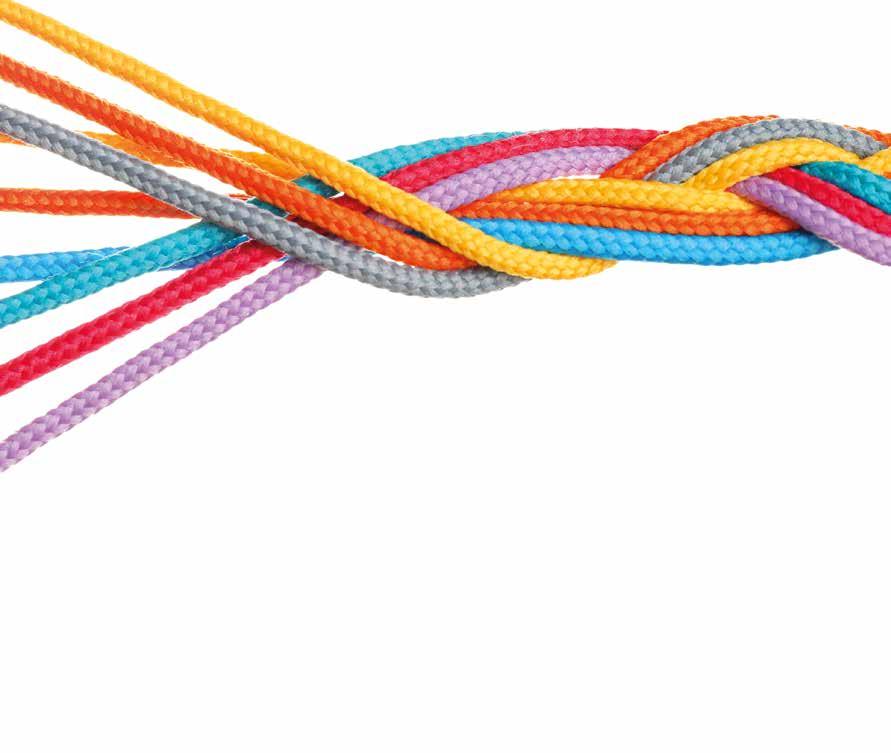


We’re here to support people like you. Join the PHA UK today and benefit from:
• Support and advice
• Helpful printed information & resources
• emPHAsis magazine delivered to your door
• Free access to financial advice from qualified professionals via our partnership with Turn2Us
• Fundraising ideas and guidance
Being part of the PHA UK also enables you to participate in important research, and our friendly office staff are just one call away when you need advice. Join our PH family and you’ll be joining 4,500 members in a unique network of support and inspiration.

Please email media@phauk.org if you’d like to contribute to your member magazine.
✓ Share your PH story
✓ Tell us your tips
✓ Submit a letter
✓ Send us your poems, pictures or photographs
✓ Pass on a feature idea
✓ Give your feedback on this issue
WOULD YOU LIKE TO CHANGE HOW YOU RECEIVE THIS MAGAZINE?
Click below to receive your copy by email instead, change your address, or cancel your subscription. You can also email hello@phauk.org
Contact us here at emPHAsis by emailing media@phauk.org or writing to emPHAsis, PHA UK Resource Centre, Unit 1, Newton Chambers Road, Thorncliffe Park, Chapeltown, Sheffield S35 2PH

We’re looking for people affected by PH, including carers and loved ones, to provide feedback on our resources and services, and lend their voices and experience to important research projects. Get involved in your own time, from the comfort of your own home.

and


✓ Regular cash prizes from £5-£25k
✓ Automatic payouts (no need to claim)
✓ Just £1 per entry
✓ Enter as many times as you like each week


“Looking for a Secret Santa gift or a thoughtful ‘thinking of you’ gesture? You can now gift your friends and family a lottery e-voucher, so you’ll be giving them the chance to win up to £25,000 whilst supporting us too.”
SHAUN, PHA UK


